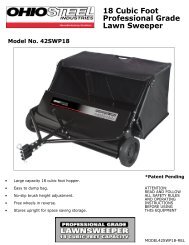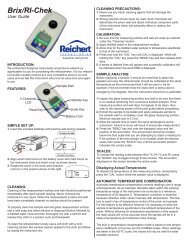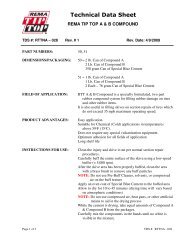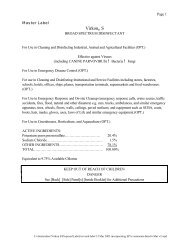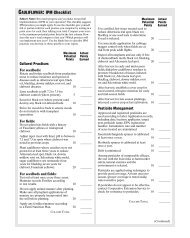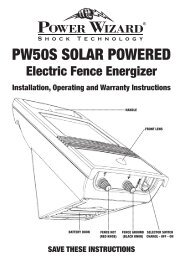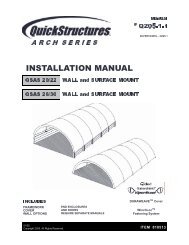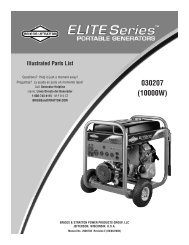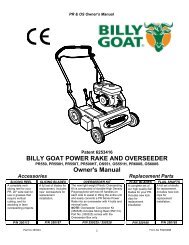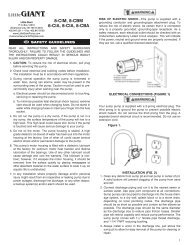Dayton® Generator
Dayton® Generator
Dayton® Generator
You also want an ePaper? Increase the reach of your titles
YUMPU automatically turns print PDFs into web optimized ePapers that Google loves.
Dayton Operating Instructions and Parts Manual<br />
Dayton ®<br />
<strong>Generator</strong><br />
2ZRR1<br />
E<br />
N<br />
G<br />
L<br />
I<br />
S<br />
H<br />
generator. Or, use a heavy duty, outdoorrated<br />
extension cord that is rated (in<br />
watts or amps) at least equal to the sum<br />
of the connected appliance loads. Check<br />
that the entire cord is free of cuts or tears<br />
and that the plug has all three prongs,<br />
especially a grounding pin.<br />
NEVER try to power the house wiring<br />
by plugging the generator into a<br />
wall outlet, a practice known as<br />
“back feeding”. This is an extremely<br />
dangerous practice that presents an<br />
electrocution risk to utility workers and<br />
neighbors served by the same utility<br />
transformer. It also bypasses some of<br />
the built-in household circuit protection<br />
devices.<br />
If you must connect the generator to<br />
the house wiring to power appliances,<br />
have a qualified electrician install the<br />
appropriate equipment in accordance<br />
with local electrical codes. Or, check<br />
with your utility company to see if<br />
it can install an appropriate power<br />
transfer switch.<br />
For power outages, permanently<br />
installed stationary generators are<br />
better suited for providing backup<br />
power to the home. Even a properly<br />
connected portable generator can<br />
become overloaded. This may result in<br />
overheating or stressing the generator<br />
components, possibly leading to a<br />
generator failure.<br />
GROUNDING INSTRUCTIONS<br />
This product must be grounded. If it<br />
should malfunction or breakdown,<br />
grounding provides a path of least<br />
resistance for electric current to reduce<br />
the risk of electric shock.<br />
Improper connection<br />
of the equipmentgrounding<br />
conductor can result in a risk<br />
of electrocution. Check with a qualified<br />
electrician or service person if you<br />
are in doubt as to whether the unit is<br />
properly grounded.<br />
The wing nut and ground terminal<br />
on the frame must always be used to<br />
connect the generator to a suitable<br />
ground source. The ground path<br />
should be made with #8 size wire.<br />
Connect the terminal of the ground<br />
wire between the two star washers<br />
and wing nut then tighten the wing<br />
nut fully. Connect the other end of<br />
the wire securely to a suitable ground<br />
source.<br />
The National Electric Code contains<br />
several practical ways in which to<br />
establish a good ground source.<br />
Examples given below illustrate a few<br />
of the ways in which a good ground<br />
source may be established.<br />
A metal underground water pipe<br />
in direct contact with the earth<br />
for at least 10 feet can be used as<br />
a grounding source. If an pipe is<br />
unavailable, an 8 foot length of pipe or<br />
rod may be used as the ground source.<br />
The pipe should be 3/4 inch trade size<br />
or larger and the outer surface must<br />
be noncorrosive. If a steel or iron rod<br />
is used it should be at least 5/8 inch<br />
diameter and if a nonferrous rod is<br />
used it should be at least 1/2 inch<br />
diameter and be listed as material for<br />
grounding. Drive the rod or pipe to<br />
a depth of 8 feet. If a rock bottom is<br />
encountered less than 4 feet down,<br />
bury the rod or pipe in a trench. All<br />
electrical tools and appliances operated<br />
from this generator, must be properly<br />
grounded by use of a third wire or be<br />
“Double Insulated”.<br />
It is recommended to:<br />
1. Use electrical devices with 3 prong<br />
power cords.<br />
2. Use an extension cord with a 3 hole<br />
receptacle and a 3 prong plug at the<br />
opposite ends to ensure continuity<br />
of the ground protection from the<br />
generator to appliance.<br />
We strongly recommend that all<br />
applicable federal, state and local<br />
regulations relating to grounding<br />
specifications be checked and followed.<br />
LINE TRANSFER SWITCH<br />
If this generator is used for standby<br />
service, it must have a transfer switch<br />
between the utility power service and<br />
the generator. The transfer switch not<br />
only prevents the utility power form<br />
feeding into the generator, but is also<br />
prevents the generator form feeding out<br />
into the utility company’s lines. This is<br />
intended to protect the serviceman who<br />
may be working on a damaged line.<br />
THIS INSTALLATION MUST BE DONE BY A<br />
LICENSED ELECTRICIAN AND ALL LOCAL<br />
CODES MUST BE FOLLOWED.<br />
engine oil<br />
Oil is a major factor affecting<br />
performance and service life. Use 4-<br />
stroke automotive detergent oil.<br />
Recommended Oil: Use 4-stroke<br />
motor oil that meets or exceeds<br />
the requirements for API service<br />
classification SJ, SL, or equivalent.<br />
Always check the API service label on<br />
the oil container to be sure it includes<br />
the letters SJ, SL, or equivalent.<br />
SAE 10W-30 is recommended for<br />
general use. Other viscosities shown<br />
in the chart may be used when the<br />
average temperature in your area is<br />
within the indicated range.<br />
THIS ENGINE<br />
CRANKCASE IS NOT



